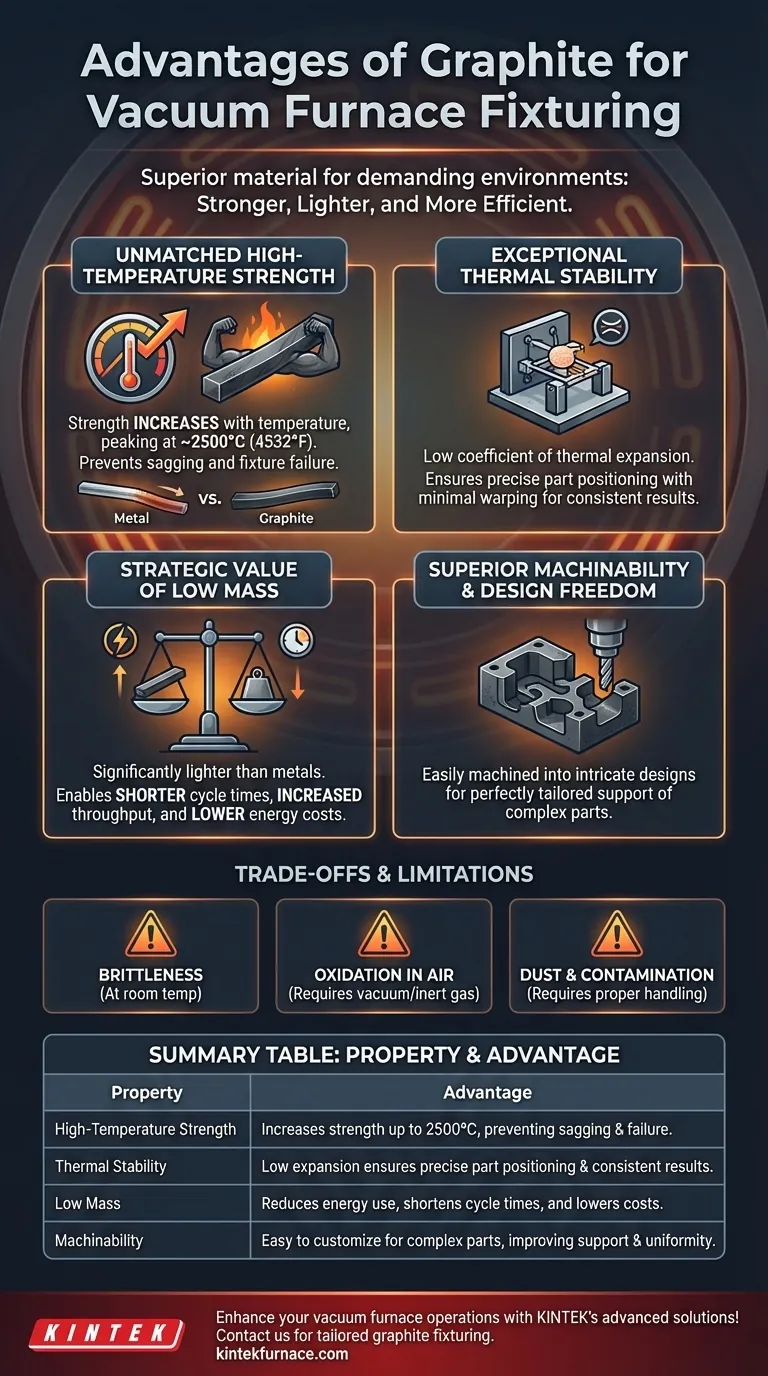In the demanding environment of a vacuum furnace, graphite is the superior material for fixturing due to its unique combination of properties. It maintains and even increases its strength at extreme temperatures, is exceptionally lightweight for faster and more efficient thermal cycles, and can be easily machined into complex shapes to support any component.
While metals weaken and warp under extreme heat, graphite grows stronger. This fundamental difference makes it a strategic choice for improving metallurgical outcomes, reducing cycle times, and lowering overall operational costs in vacuum heat treating.
The Core Properties Driving Graphite's Advantage
To understand why graphite is so dominant in this application, we must look beyond its simple heat resistance. Its value comes from a synergy of thermal, mechanical, and physical properties that are perfectly suited for a vacuum environment.
Unmatched High-Temperature Strength
Unlike metals, which lose tensile strength as they get hotter, graphite exhibits a counter-intuitive behavior. Its strength actually increases with temperature, peaking at around 2500°C (4532°F).
This means that a fixture that is strong on the shop floor is even stronger and more reliable at the process-critical peak temperature inside the furnace. This prevents sagging, distortion, and fixture failure.
Exceptional Thermal Stability
Graphite has a very low coefficient of thermal expansion. It barely expands or contracts when heated and cooled rapidly.
This stability is critical for precision work. It ensures the fixture holds the workpiece in the exact desired position without inducing stress or warping, leading to more consistent and predictable metallurgical results.
The Strategic Value of Low Mass
Graphite is significantly lighter than the high-temperature metal alloys often used for fixturing, such as molybdenum or nickel-chrome.
This low mass has a direct impact on your bottom line. Less energy is required to heat the fixture itself, and it cools down faster. This translates directly to shorter cycle times, increased furnace throughput, and lower energy costs.
Superior Machinability and Design Freedom
Graphite is relatively soft and can be machined quickly and cost-effectively into intricate and custom designs.
This allows for the creation of fixtures perfectly tailored to support complex or delicate parts, ensuring uniform heating and preventing distortion. The ability to rapidly prototype and produce custom fixtures is a significant advantage over hard-to-work metal alloys.
Understanding the Trade-offs and Limitations
While highly advantageous, graphite is not without its operational considerations. Acknowledging these limitations is key to using it successfully.
Brittleness at Room Temperature
While incredibly strong when hot, graphite can be brittle at room temperature. Fixtures must be handled with care to avoid chipping or catastrophic failure from being dropped or struck.
Oxidation in Air
Graphite’s benefits are realized in a vacuum or inert gas atmosphere. When heated in the presence of oxygen, graphite will rapidly oxidize (burn away), leading to fixture degradation and failure.
Potential for Dust and Contamination
Machining and handling can create fine graphite dust. Proper housekeeping and cleaning protocols are essential to prevent this dust from contaminating sensitive components, especially in cleanroom or aerospace applications.
Making the Right Choice for Your Application
Selecting graphite is a strategic decision that should align with your primary processing goals.
- If your primary focus is throughput and efficiency: Graphite's low mass is its greatest asset, enabling faster heating and cooling cycles that directly reduce energy costs and increase furnace capacity.
- If your primary focus is processing complex or delicate parts: Graphite's superior machinability and low thermal expansion allow for custom, stable fixtures that prevent part distortion.
- If your primary focus is high-temperature processing (>1200°C): Graphite's unique ability to get stronger with heat makes it the only reliable and cost-effective choice where metal fixtures would fail.
Ultimately, choosing graphite fixturing is an investment in process control, efficiency, and consistent, high-quality results.
Summary Table:
| Property | Advantage in Vacuum Furnace Fixturing |
|---|---|
| High-Temperature Strength | Increases strength up to 2500°C, preventing sagging and failure |
| Thermal Stability | Low expansion ensures precise part positioning and consistent results |
| Low Mass | Reduces energy use, shortens cycle times, and lowers costs |
| Machinability | Easy to customize for complex parts, improving support and uniformity |
Enhance your vacuum furnace operations with KINTEK's advanced solutions! Leveraging exceptional R&D and in-house manufacturing, we provide diverse laboratories with high-temperature furnace systems like Muffle, Tube, Rotary, Vacuum & Atmosphere Furnaces, and CVD/PECVD Systems. Our strong deep customization capability ensures we precisely meet your unique experimental needs. Contact us today to discuss how our tailored graphite fixturing and furnace technologies can boost your efficiency and precision!
Visual Guide

Related Products
- Molybdenum Vacuum Heat Treat Furnace
- Vacuum Heat Treat Sintering Furnace with Pressure for Vacuum Sintering
- Vacuum Heat Treat Furnace with Ceramic Fiber Liner
- Vacuum Hot Press Furnace Machine Heated Vacuum Press Tube Furnace
- 2200 ℃ Graphite Vacuum Heat Treat Furnace
People Also Ask
- What operational advantages do vacuum furnaces provide? Achieve Superior Material Quality and Process Control
- What are the primary functions of a vacuum furnace? Achieve Superior Material Processing in a Controlled Environment
- What additional processes can a vacuum heat treatment furnace carry out? Unlock Advanced Material Processing
- How does a vacuum heat treatment furnace prevent contamination? Ensure Purity in High-Temperature Processes
- What does a vacuum furnace do? Achieve Superior Material Processing in a Pure Environment



















